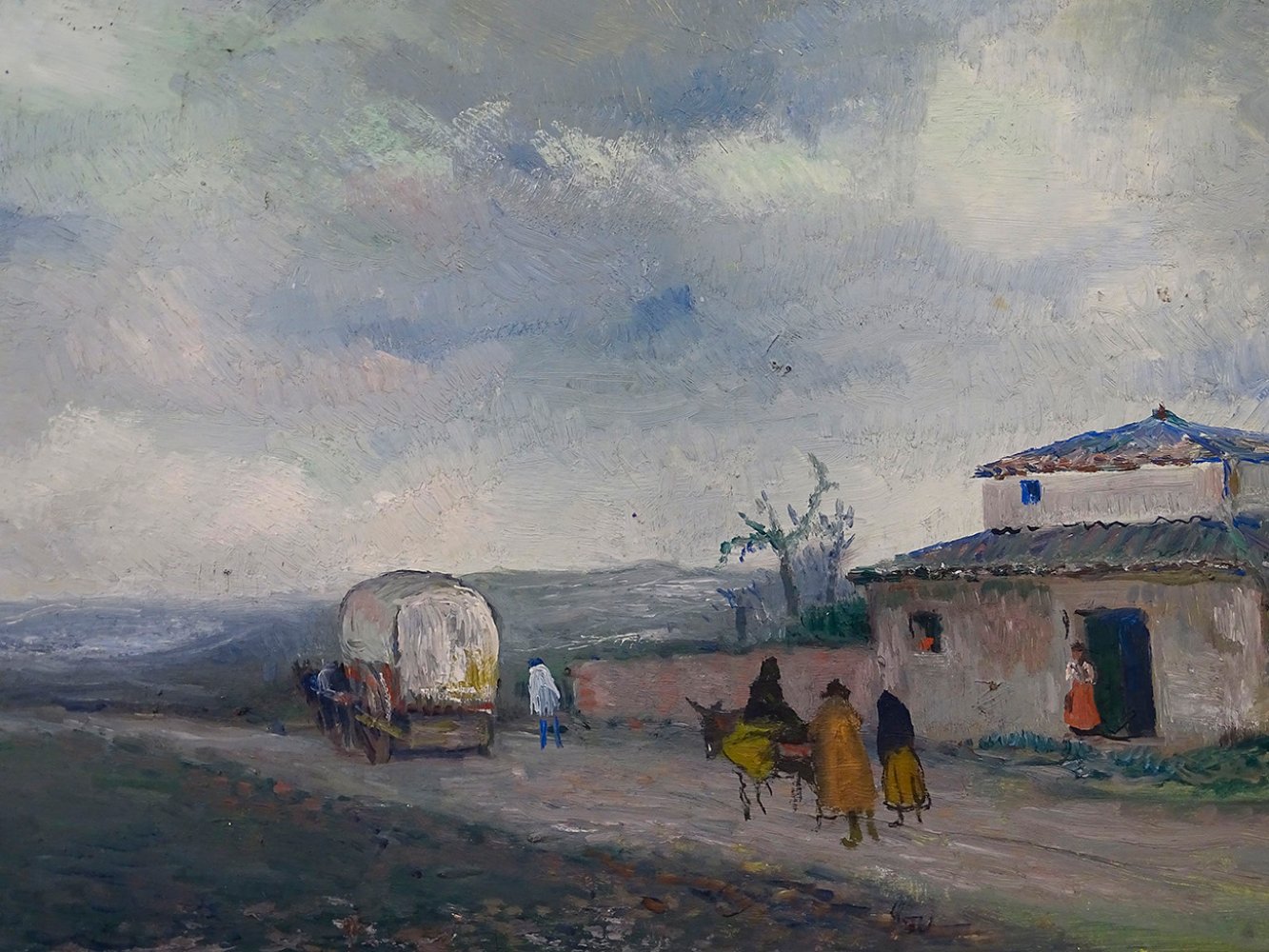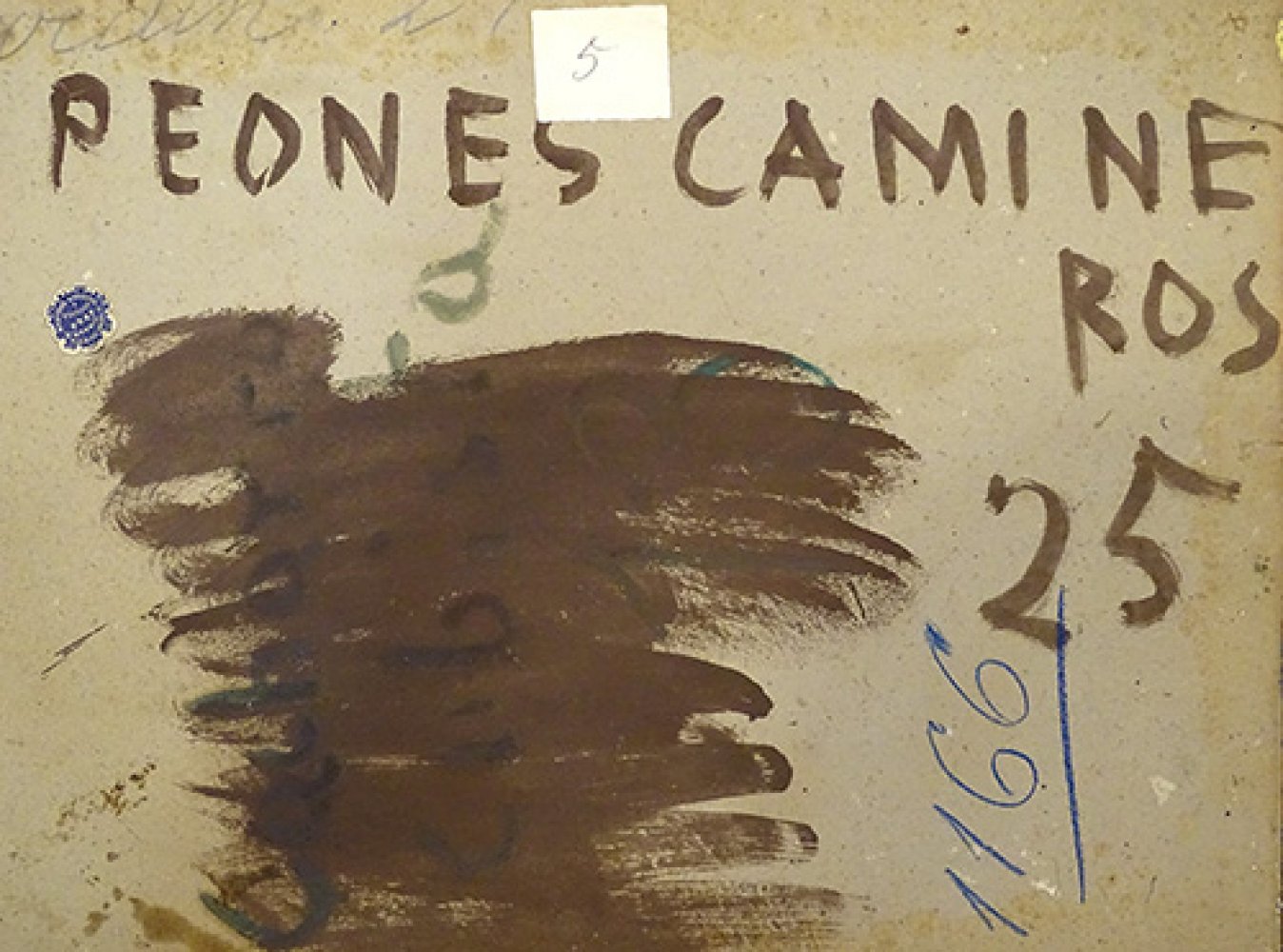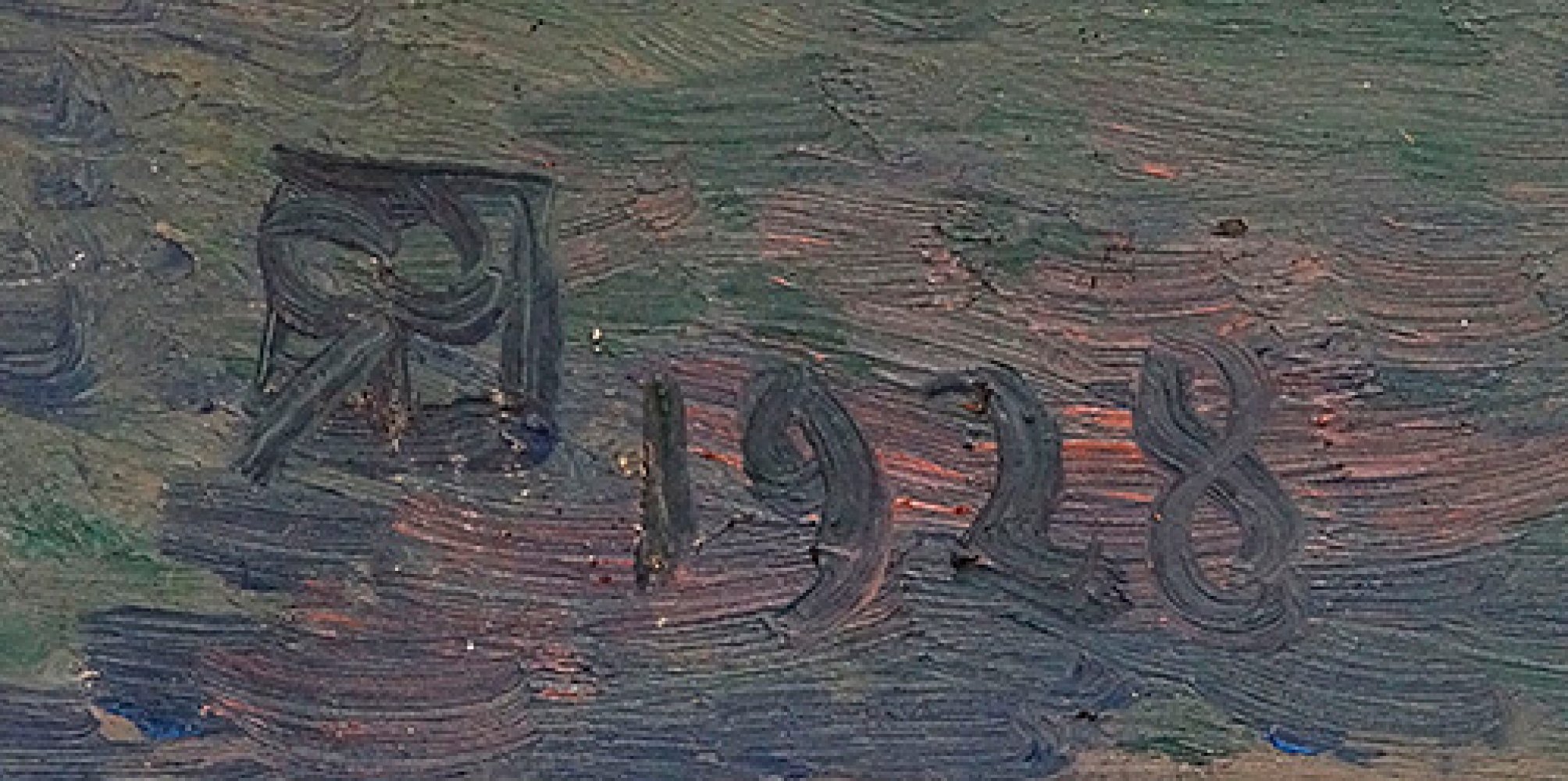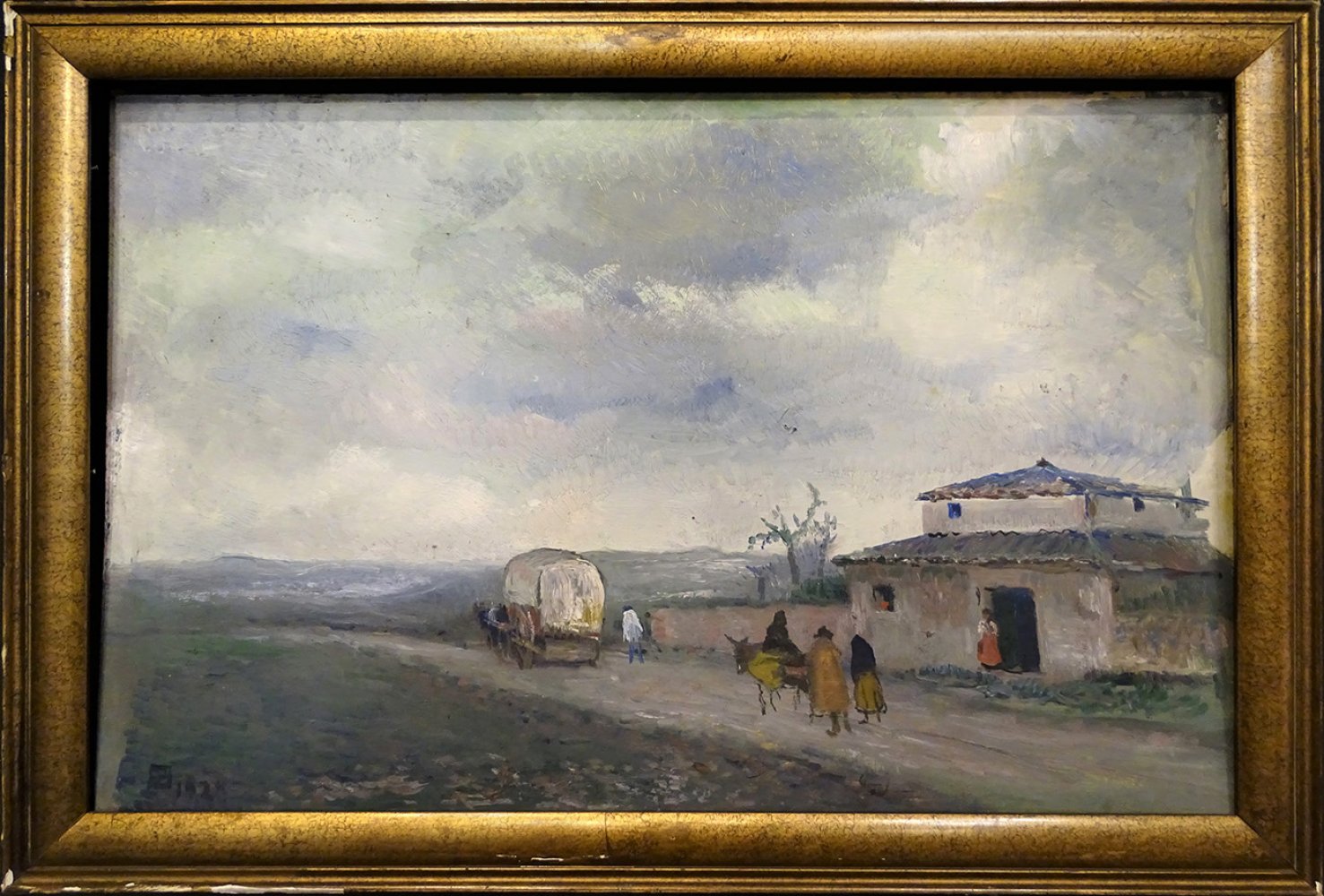7
RICARDO BAROJA NESSI (Riotinto, Huelva, 1871 - Vera de Bidasoa, Navarre, 1953).Peones camineros" ("
Peones camineros" ("Road workers"), 1925-1928.
Oil on cardboard.
Signed with monogram and dated. Titled and dated on the back.
Provenance: private collection of Doña Teresa Cañaréis de Marshall, heiress of Enrique Granados, a well-known Spanish musician who was a contemporary of Ricardo Baroja. Both people moved in the same artistic circle of the time, which establishes a solid historical traceability of the present work.
Size: 56.5 x 37 cm; 64 x 45 cm (frame).
Ricardo Baroja's passion for the landscapes of the inland villages of Spain, some of which were even lost, is demonstrated in the present work. At the beginning of the 20th century, the Huelva-born artist travelled the country from inn to inn, either for his work as a painter or for his hobby as a hiker. There he immortalised the inn maids and muleteers who transported him, the taverns where he was fed and the boarding houses where he stayed overnight. Through his particular technique, agile and swift, Baroja captured like no one else the popular life of the most inhospitable villages in Spain, and his unique and highly identifiable style.
A painter, engraver and writer of the Generation of '98, and brother of Pío Baroja, he was self-taught. Developing a style contrary to the aesthetic taste of the artistic juries of the beginning of the century, Baroja took part in the Bilbao Modern Art Exhibition from 1900 onwards, and exhibited his work in different places, preferably San Sebastián and Madrid. Around 1900-1906 he devoted himself to etching, and came to be considered the best Spanish master in this field after Goya, standing out from the outset as a profound portraitist, the author of beautiful etchings and scenes of popular life, somewhere between Goyaesque and lyrical. He also devoted himself to writing at the same time. In 1903 he founded, in collaboration with Pablo Picasso and Francisco de Asís Soler, the "Arte Joven" group. In 1928 he was appointed professor at the National School of Graphic Arts. However, following a traffic accident, the artist lost an eye and was forced to give up painting, concentrating from then on on literature. Gradually he took up brushwork again, but he hardly ever painted from life. During the Civil War he lost contact with his brother, who fled to France, and he earned his living by painting. After the war he continued to paint, although only in summer, and to write. From 1940 onwards he again held exhibitions in the art galleries of San Sebastian, Bilbao and Madrid, obtaining great commercial success. In San Sebastián he founded, together with Martiarena, the Guipúzcoa Artistic Association. In 1952, a year before his death, his success was confirmed with the sale of all his paintings at an exhibition held in San Sebastian. Ricardo Baroja is represented in the Provincial Museum of Lugo, the Fine Arts Museums of Bilbao and Álava, and the San Telmo Museum in San Sebastián, among others.
Peones camineros" ("Road workers"), 1925-1928.
Oil on cardboard.
Signed with monogram and dated. Titled and dated on the back.
Provenance: private collection of Doña Teresa Cañaréis de Marshall, heiress of Enrique Granados, a well-known Spanish musician who was a contemporary of Ricardo Baroja. Both people moved in the same artistic circle of the time, which establishes a solid historical traceability of the present work.
Size: 56.5 x 37 cm; 64 x 45 cm (frame).
Ricardo Baroja's passion for the landscapes of the inland villages of Spain, some of which were even lost, is demonstrated in the present work. At the beginning of the 20th century, the Huelva-born artist travelled the country from inn to inn, either for his work as a painter or for his hobby as a hiker. There he immortalised the inn maids and muleteers who transported him, the taverns where he was fed and the boarding houses where he stayed overnight. Through his particular technique, agile and swift, Baroja captured like no one else the popular life of the most inhospitable villages in Spain, and his unique and highly identifiable style.
A painter, engraver and writer of the Generation of '98, and brother of Pío Baroja, he was self-taught. Developing a style contrary to the aesthetic taste of the artistic juries of the beginning of the century, Baroja took part in the Bilbao Modern Art Exhibition from 1900 onwards, and exhibited his work in different places, preferably San Sebastián and Madrid. Around 1900-1906 he devoted himself to etching, and came to be considered the best Spanish master in this field after Goya, standing out from the outset as a profound portraitist, the author of beautiful etchings and scenes of popular life, somewhere between Goyaesque and lyrical. He also devoted himself to writing at the same time. In 1903 he founded, in collaboration with Pablo Picasso and Francisco de Asís Soler, the "Arte Joven" group. In 1928 he was appointed professor at the National School of Graphic Arts. However, following a traffic accident, the artist lost an eye and was forced to give up painting, concentrating from then on on literature. Gradually he took up brushwork again, but he hardly ever painted from life. During the Civil War he lost contact with his brother, who fled to France, and he earned his living by painting. After the war he continued to paint, although only in summer, and to write. From 1940 onwards he again held exhibitions in the art galleries of San Sebastian, Bilbao and Madrid, obtaining great commercial success. In San Sebastián he founded, together with Martiarena, the Guipúzcoa Artistic Association. In 1952, a year before his death, his success was confirmed with the sale of all his paintings at an exhibition held in San Sebastian. Ricardo Baroja is represented in the Provincial Museum of Lugo, the Fine Arts Museums of Bilbao and Álava, and the San Telmo Museum in San Sebastián, among others.
30th June - 19th & 20th Century Art
Sale Date(s)
Venue Address
General delivery information available from the auctioneer
Setdart offers Worldwide shipping
PICK UP IN ROOM: You can come and pick up your lots in our offices (Barcelona, Madrid or Valencia). At the moment of the withdrawal, you will be able to accept the current conditions of the lot by means of a document that you will sign.
YOU CAN SEND ANOTHER PERSON TO PICK UP: This person must present a signed authorization that you can find in our web page by accessing from BUY AT SETDART- LOGISTICS-DOWNLOAD AUTHORIZATION DOCUMENT. You can also send an e-mail with the requested data in AUTHORIZATION DOCUMENT to admin@setdart.com
Important Information
25% buyer´s premium
21% buyer´s premium at www.setdart.com
Terms & Conditions
The maximum period to pay the lots is 7 working days. You can pay either via bank transfer or with credit card through our platform www.setdart.com (we only accept VISA or Mastercard).
BUYER´S PREMIUM: 22% Hammer price + 21% VAT from the buyer´s premium
If your piece has more than 100 years, our Ministry of Culture requires an export certificate in order for the piece to leave the country. Note that if the piece goes inside the EU, there is no cost for the export certificate. If the piece goes outside the EU, there is a cost for the export certificate. You can find more information in our Ministry of Culture website: https://www.culturaydeporte.gob.es/en/cultura/patrimonio/exportacionimportacion/exportacion/tasas.html
INQUIRIES: admin@setdart.com
Setdart guides you through the entire process, from the time of award to the day you receive your lot. Our logistics team will be happy to manage your transport, and will advise you on the best shipping method with professionals from the sector used to handling works of art and jewelry.
WE OFFER WORLDWIDE DOOR TO DOOR SHIPPING
PICK UP IN ROOM: You can come and pick up your lots in our offices. At the moment of the withdrawal, you will be able to accept the current conditions of the lot by means of a document that you will sign.
YOU CAN SEND ANOTHER PERSON TO PICK UP: This person must present a signed authorization that you can find in our web page by accessing from BUY AT SETDART-LOGISTICS-DOWNLOAD AUTHORIZATION DOCUMENT. You can also send an e-mail with the requested data in AUTHORIZATION DOCUMENT to admin@setdart.com
SETDART IS NOT RESPONSIBLE FOR THE STATE OF THE PARTS ONCE THEY LEAVE OUR FACILITIES. MRW SHIPMENTS: Once the payment is made, your lot will be packed for shipment, the logistics department will send you an e-mail notifying you of the day it leaves our warehouse, changes of address cannot be made after receiving this e-mail.
INSURANCE INCIDENTS: Coverage for the value of the auction up to 3000 ? per shipment, if the value of the auction is higher, Setdart will send you a quote including the additional insurance. The insurance company WILL NOT BE RESPONSIBLE FOR THE SHIPMENT THAT EXCEEDS THAT AMOUNT AND IS NOT FULLY INSURED. MRW INCIDENTS: Maximum notification 48 hours after receipt, after which the insurance company WILL NOT BE RESPONSIBLE AND NO CLAIMS WILL BE ACCEPTED.
E-MAIL LOGISTICS: logistica@setdart.com
PICK UP YOUR MESSAGES: You can send your own messaging, prior notice via e-mail that your shipment is ready, please note 3 or 4 days in advance. This type of shipment is packaged so Setdart will provide you with a quote.
EXPENSES FOR STORAGE: We inform you that if the purchased lot is not picked up within a month, you will be charged 30€ per week per lot. Setdart Online S.L., owner of the web site "setdart.com", "setdart.net" and "setdart.org", acts as a company of Spanish nationality inscribed in the Volume 36955, sheet 182, page B-293056 of the Mercantile Registry, with registered office at Calle Aragó












